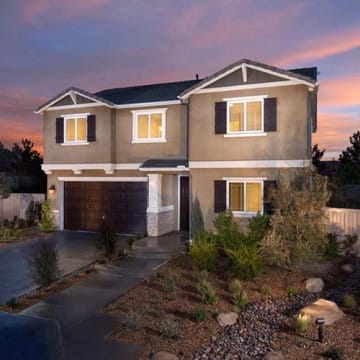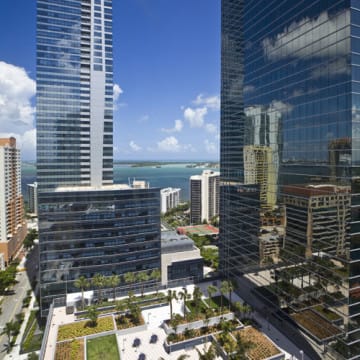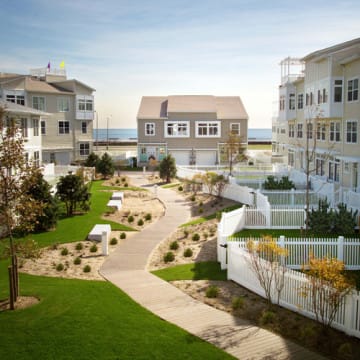Bayshore Villas
As of spring 2020, 174 families in Old San Juan can view the Caribbean sunset from their windows in Bayshore Villas. Those residents earn a range of incomes. They rent their homes in a market where renting traditionally was arranged informally in standalone houses. They move along paths and through green areas with neighbors from many walks of life. And their presence testifies to how developer McCormack Baron Salazar, through a steady partnership with both the local Department of Housing and local architects, saw the project through the billions of dollars in damages caused by Hurricanes Maria and Irma in 2017, as well as the delays in insurance payments that followed. As Puerto Ricans face more turbulent weather, Bayshore Villas shows how disaster-ready design can also help cultivate community.
Hurricane Maria gnawed through Puerto Rico’s streets, homes, and power lines, leaving more than half the island without electricity for months. Yet it caused just a pause in lease-up and construction at Bayshore Villas. Puerto Ricans spread the word that this complex stood up to the storm: after the lights came back on across the island, 2,400 families had applied for one of the only 40 market-rate apartments. Today, as recent earthquakes challenge local resilience planning, other developers have started assembling financing for projects that follow Bayshore Villas’ lead.
How does such success occur? The answer starts with the experience brought to the project by McCormack Baron Salazar. Richard Baron cofounded the firm in St. Louis in 1973; earlier, he had represented tenants of that city’s failed Pruitt-Igoe public housing complex. When the firm began operations, it raised capital for core-city developments as polished and aesthetically consistent as luxury townhouses. The firm proved time and again that good design and strong property management could foster vibrant places where people of different incomes enjoy living together. As those complexes recouped their investment, the firm spread its footprint. It became a premier firm for delivering mixed-income housing, which earned it an invitation to Puerto Rico.
Adapting its approach through strategic local partnerships earned the firm the trust it needed in a new kind of low-rise market. In San Juan, the firm’s leaders, as they always do, selected a well-known and respected local architecture firm, then worked closely with that firm to make the project a template for hurricane-ready construction. That firm was Álvarez-Díaz & Villalón, which has offices in Miami and San Juan.
The architecture and development plans yielded a resilient but welcoming complex. The site’s underground storm chambers detain over 70,000 gallons of stormwater, so heavy rains cause less damage. The electricity loads of the common areas are offset by a solar photovoltaic system through net metering, and those loads can be met by backup generators for several days after a power outage. The development also has impact-resistant windows and doors, and reinforced concrete is used in the exterior structures. As a result, the entire system resists windborne debris, hurricane-force winds, and the intense fluctuations in air pressure a storm can bring.
Lead architect Ricardo Álvarez-Díaz, cofounder and chief executive officer of Álvarez-Díaz & Villalón, says early discussions led to power-supply strategies and use of storm-resistant materials. “We always knew that a disaster may happen,” he says. “A resilient and sustainable approach was introduced as a way to create value and provide innovative, transformative, and socially responsible solutions that lead to the betterment of the community. This has to be the norm for us to adapt, endure, and thrive as a society.”
This approach made good economic and social sense to McCormack Baron Salazar as well. “Lower-income residents are the least able to recover, financially, from the negative impact of a storm,” says Cady Seabaugh, vice president of communications and sustainability at McCormack Baron Salazar. “We knew we had to make the property hurricane resilient for several reasons, the most important of which was to help our lower-income residents continue to move up the economic ladder. Not only does the resilient design protect the private and public investment in the property, but also it protects the residents and families the property is meant to serve.”
The buildings and grounds survived Hurricane Maria with materials equal to the storm. The construction process also survived a supply crunch for building materials through a common effort by the builder, the design team members, and the Puerto Rico Department of Housing.
The design aspects applied at Bayshore Villas help it serve San Juan residents in all circumstances—fitting the mission that led the Department of Housing to select McCormack Baron Salazar in 2013.
The good faith among leaders at the Department of Housing, indeed, set Bayshore Villas in motion years before Maria hit the island. In 2013, reformist officials in Puerto Rico resolved to replace inward-facing public housing towers near the waterfront with mixed-income apartments that encourage residents to mingle in public spaces. Such design approaches fostering interaction can build familiarity and trust among residents, encouraging them to support each other during extreme events—a key aspect of community resilience.
Even before the storm, the apartments entered uncharted territory. The apartments would mainly serve low-income neighbors, but 22 percent of the units would be rented at market rates. This concept would require a new way of thinking and a new type of project approach for Puerto Rico. That conviction led consultants at the Department of Housing to contact McCormack Baron Salazar president Vincent Bennett. For the firm, the opportunity to bid for the San Juan project presented a challenge: it would have to take an approach to the site as exacting as it ever had, but in a breathtaking waterfront setting near some of San Juan’s toniest homes—and on a site that doubtlessly would face storm surge.
As Bennett recalls, other than the tropical trees, the Old San Juan sites resembled the scarred neighborhoods his firm had helped heal elsewhere. “Secretary of Housing Alberto Lastra and his successor Fernando Gil were very interested, as was HUD [the U.S. Department of Housing and Urban Development], in breaking the psychological barrier that prevented families of different incomes living side by side in the same building.” McCormack Baron Salazar’s team proceeded with confidence that Lastra, who trained as an architect, understood how urban design in an Instagram-worthy location would create market-rate demand.
In part, the government preferred a mixed-income model to replace public housing because federal subsidies for public housing had shrunk and would dwindle more in future years. Officials needed market-rate rents to help subsidize low-income apartments—and they needed a project that would thrive on its own. “Initially this meant many meetings with high-level department directors, midlevel directors, and resident leaders,” recalls Bennett. “We were sharing a lot of collateral material from other cities—case studies and designs. It was an intensive, intentional effort at chipping away at skepticism.”
Skepticism began to fade when McCormack Baron empowered Álvarez-Díaz & Villalón to lead the design team’s outreach efforts. Architect Álvarez-Díaz, who worked for years in New York before opening his own firm, quickly moved from sharing drawings to visiting with local residents in order to sharpen the project’s details.
As he recalls, the team succeeded in crafting a workable budget and specifying an outward-looking design for two reasons: members worked with the Department of Housing to navigate administrative barriers, and they huddled with residents to build trust. “At our firm, we always design projects that include sustainability and resiliency measures from the implementation phase for the building, site, and surroundings,” says Álvarez-Díaz. “This is not just for a specific project, but for all. This is not an afterthought or a reaction to current trends, but part of the responsibilities in our holistic approach.”
From his San Juan office, Álvarez-Díaz recalls how he had seen Miguel Hernandez Vivoni, Lastra’s predecessor, sit with public-housing residents and hear their fears about daily crime in the dark, boxy towers where they lived. That outreach, he says, helped residents express design priorities for Bayshore Villas and a companion project called Renaissance Square. The government’s support for the outreach then showed that the Department of Housing would work with him and his client to foster a close-knit and walkable community.
“Both the Puerto Rico Department of Housing and the regional HUD office were willing to work with the rules toward a goal in which we were not simply building housing but building community,” says Álvarez-Díaz.
The project mixed Álvarez-Díaz’s local knowledge of site planning, architectural design, local culture, and materials with McCormack Baron Salazar’s expertise in financing, community transformation, and overall development. Bayshore Villas, like McCormack Baron Salazar’s successes in St. Louis, Atlanta, and elsewhere, is oriented toward the street. The 12 buildings that make up Bayshore Villas top out at four stories. Windows greet the public paths and the waterfront. The unit mix fits within uniform building shapes and efficient use of space, but with variations in the exterior treatment. This approach restated development theses McCormack Baron Salazar had convincingly pursued in former industrial cities. Adapting it to this context, says Bennett, meant learning new design strategies.
In response to input from local experts, the team constructed winding paths and large plazas as places for gathering. For the design elements that would attract families from all walks of life, the teams pooled their knowledge. Álvarez-Díaz led a planning session with neighbors of the site, and the developers brought the architects to tour sites in Florida and St. Louis that had grown with financing structures similar to that of Bayshore Villas. “The design team led us in sitting down and having a good exchange with local contractors around what’s worked well on the island,” Bennett says.
Bayshore Villas echoes communities McCormack Baron had built in colder climates but does not copy them. “We learned the importance of trade winds in how you orient buildings to take advantage of air circulation,” Bennett says. “This is especially important after storm events so residents can open their windows when there is no AC, but is also part of the culture of the community.”
Nothing on the construction drawings or spec sheets changed after the storm, according to Bennett and Álvarez-Díaz. “The only items we’re looking to add are backup generators, which we initially limited to common buildings due to budget,” says Bennett. Looking ahead, he adds, the team wants to write scenario plans to help tenants get medicine and air conditioning if power again goes down for several days. Looking back, the main challenges involved cutting checks to contractors due to delays in insurance payouts and keeping connected with former residents, he says.
The mixed-income model survived Maria as visibly as the structures do. Bennett says his firm kept faith with the model by declining to revise the waiting list to let market-rate tenants bid up available apartments. “The underwriting specified what we could charge, and that was appropriate,” Bennett says. “We had a waiting list and no interest in gouging.”
Now that affluent San Juan residents have shown interest in mixed-income living, other local developers have started building competitive projects. If those competitors want to see complex projects through Maria’s certain sequels, their teams might draw inspiration from these lessons.
Lessons Learned
Create construction plans and budgets that assume a storm will strike—and arrange financing with the assumption that insurance will not pay you back. Insurance reimbursements remained slow or were missing as the developers went through the final punch list and lease-up. Governments, even cooperative ones, cannot cover losses at this scale. Bennett suggests building a budget around grants and forgivable loans, and with money from investors in tax-credit schemes, to help ensure that contractors and professionals can go back to earning paychecks before insurers pay out on developers’ claims (or if they never do).
Build trust with civic leaders to safeguard your return on investment. The slow approvals and construction process produced a consistent design and marketing budget because community leaders had weighed in on the project, says Álvarez-Díaz, and because they felt free to keep speaking up as the project took shape. McCormack Baron Salazar’s clear signal that local authorities could steer the development process made for willing partners in government and the outreach that Álvarez-Díaz conducted made the property attractive. After the shock of Hurricane Maria, this confidence paid off in steady leasing.
Master local history and share your own history. Stories had been swirling for years in San Juan about a government willing to invest in mixed-income designs, according to Álvarez-Díaz. When Bennett chose Álvarez-Díaz’s firm, McCormack Baron Salazar gained access to stories and priorities from residents who had tentatively started trusting the redevelopment process several years earlier. Likewise, Álvarez-Díaz & Villalón prepared drawings for Bennett with the knowledge that the client had delivered and sustained mixed-income successors to poverty-trap projects in cities across the United States. Because the developer and designer both gained reasons for confidence in their vision, design work proceeded to include ambitious sustainable elements like solar panels. It also proceeded despite the storm.
Trust in a local partner. Álvarez-Díaz salutes McCormack Baron Salazar for growing fluent in San Juan’s culture. “When I say culture, I don’t mean music and dance,” Álvarez-Díaz says. “I mean political culture.” Bennett and his staff had met and spoken regularly with regulators during the years it spent revising its request for qualifications and completing its budget. They knew both how the Department of Housing had explored community-based design ideas and how partisans had let old models persist after they had lost favor elsewhere in the United States. That knowledge gave Bennett license to call and re-call officials when they needed funds and crews after Hurricane Maria.


